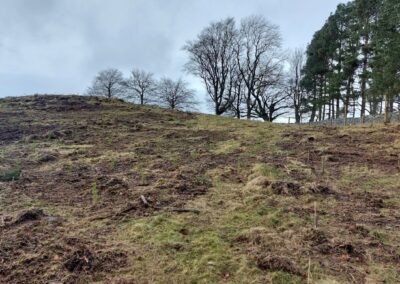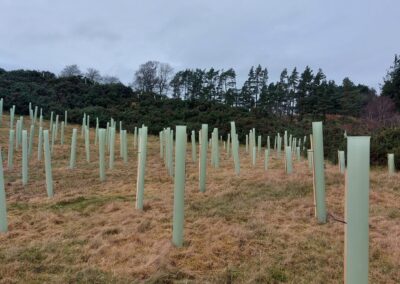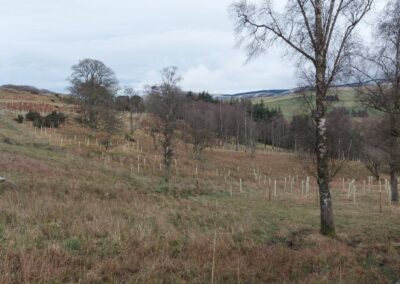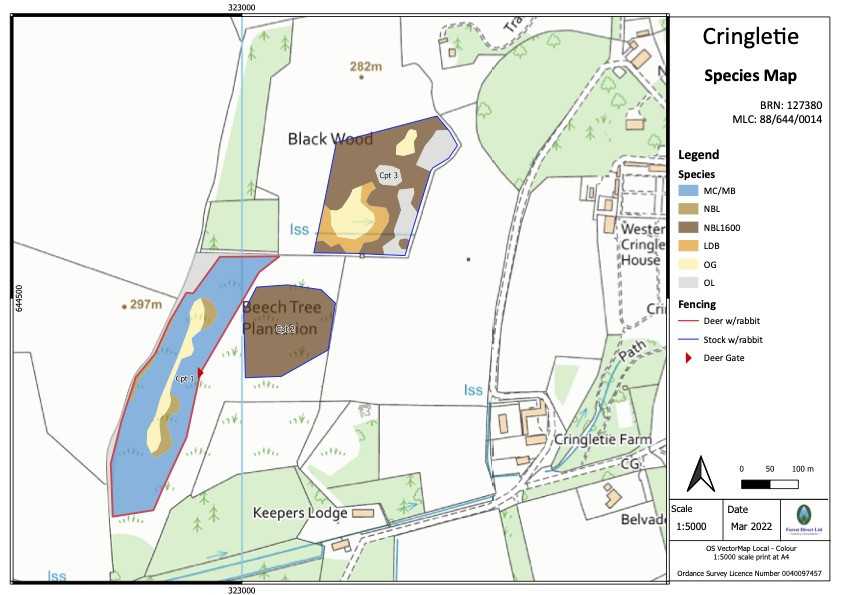The planting sites are located to the west of the farm on a gentle slope which overlooks Cringletie House Hotel and mature policy woodlands. The client aims to balance sustainable agriculture with biodiversity gain. The hotel owners were also consulted and it was agreed a mix of diverse conifers and broadleaves would best preserve the hotel’s view of the hill. As a result, Forest Direct Ltd designed and delivered a diverse 21st-century woodland suited to the site’s conditions and the client’s objectives.
Objective and Vision
The client’s vision was to restore woodland cover to areas where historical maps show woodland once covered. The key project objectives were improving the local landscape, increasing native woodland cover and farm shelter as well as species diversity, encouraging natural woodland development, controlling the spread of gorse and providing timber production for farm use, firewood and fencing material. The client also requested we plant Larix decidua without grant funding throughout the diverse conifer mix.
Fast Facts
Client: Ross Macleod, Cringletie Farm
Project developer: Forest Direct Ltd
Previous land use: Agriculture
Species Mix:
Small farm woodland option 2500/ha:
Oak 25%,
Scots Pine 20%,
Norway spruce 20%,
Silver birch 20%,
Douglas fir 10%,
Aspen 5%.
Small farm woodland option 1100/ha:
Silver birch 40%,
Cherry 20%,
Hawthorn 10%,
Rowan 10%,
Aspen 10%,
Blackthorn 10%.
Native broadleaf option 1600/ha:
Oak 40%,
Silver birch 30%,
Alder 10%,
Aspen 10%,
Rowan 10%.
Low-density Native Broadleaves:
Alder 50%
Willow 50%
Open Ground 9.6%
Woodland Management:
Minimum intervention of broadleaves for long-term habitat retention
Estimated net carbon Sequestration (tCO2): 1,327 tonnes
Woodland Carbon Code – Group scheme
Trees planted: 6515
Woodland Management: Selective or group felling of conifers as required Estimated net carbon Sequestration (tCO2): 1304 Tonnes
Start date: 9th December 2021
End date: 2nd January 2022
Approach
The species planted were chosen to maximise diversity and biodiversity, with the sustainability of resources, ecosystems and income in mind. Each species is suited to the climatic and soil conditions. Native woodland was proposed in primary and secondary areas to increase the sustainability of existing native woodland. Groundwater Dependent Terrestrial Ecosystems (GWDTE) were protected as open space, and feathered planting to the sides was included with Low-density broadleaves. Ultimately a robust species mix of 50% MB. A view from rocky outcrops was retained as a ‘vista’ in compartment 1.
The project was funded by the Forestry Grant Scheme [in digital version link to article] using the Small or Farm Woodlands, Native Broadleaves and Low-density Broadleaves options. The proposals were received positively by the community.The local community council, adjacent properties and the Cringletie House Hotel were all notified of the proposed planting, and no concerns were raised.
Once established, the shelters protecting the broadleaves will be removed, and the trees will receive minimum management. The conifers will be felled in groups or selectively felled as the requirements of the time see fit.
The scheme is set to meet all objectives set by the client, creating additional income for the farm unit as well as a sustainable resource, improved biodiversity and shelter for livestock.
The project was registered on Markit under the UK Woodland Carbon Code for 1304 tonnes of carbon project to be sequestered over the woodlands’ lifetime.




